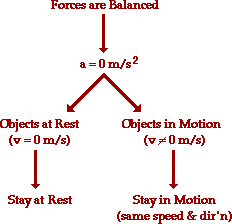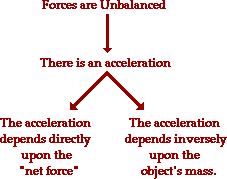Lesson 3:
Newton's Second Law of
Motion
Newton's Second Law
Newton's first law of motion
predicts the behavior of objects for which all existing
forces are balanced. The first law - sometimes referred to
as the "law of inertia" - states
that if the forces acting upon an object are balanced, then
the acceleration of that object will be 0 m/s/s. According
to Newton, an object will only accelerate if there is a
net or
unbalanced force acting
upon it.

Newton's second law of motion pertains to the behavior of
objects for which all existing forces are not
balanced. The second law states that the acceleration of an
object is dependent upon two variables - the
net force acting upon the object
and the mass of the object. As learned in the "The Rocket
Simulation" Lab, the acceleration of an object depends
directly upon the net force acting upon the object, and
inversely upon the mass of the object. As the force of
propulsion acting upon the rocket-chair increased, the
acceleration of the rocket-chair increased. As the mass of
the rocket-chair increased, the accleration of the
rocket-chair decreased.

Newton's second law of motion can be
formally stated as follows:
The acceleration of an object as
produced by a net force is directly proportional to the
magnitude of the net force, in the same direction as the net
force, and inversely proportional to the mass of the object.
 In
terms of an equation, the net force is equated to the
product of the mass times the acceleration. In
terms of an equation, the net force is equated to the
product of the mass times the acceleration.
Fnet
= m * a
In this entire discussion, the emphasis has been on the
"net force." The acceleration is directly proportional to
the "net force;" the "net force" equals mass times
acceleration; the acceleration in the same direction as the
"net force;" an acceleration is produced by a "net force."
The NET FORCE. It is important to remember this distinction.
Do not use the value of merely "any 'ole force" in the above
equation; it is the net force which is related to
acceleration. As discussed in an
earlier lesson, the net force is the vector sum of all
the forces. If all the individual forces acting upon an
object are known, then the net force can be determined. If
necessary, review this principle by returning to the
practice questions in Lesson
2.
The above equation also indicates that a unit of force is
equal to a unit of mass times a unit of acceleration. By
substituting standard metric units for force, mass, and
acceleration into the above equation, the following unit
equivalency can be written.

The definition of the standard metric unit of force is
stated by the above equation. One Newton is defined as the
amount of force required to give a 1-kg mass an acceleration
of 1 m/s/s.
The Fnet = m a equation can also be
used as a "recipe" for algebraic problem-solving. The table
below can be filled by substituting into the equation and
solving for the unknown quantity. Try it yourself and then
use the "pop-up menus" to view the answers.
|
|
Net
Force
(N)
|
Mass
(kg)
|
Acceleration
(m/s/s)
|
|
1.
|
10
|
2
|
|
|
2.
|
20
|
2
|
|
|
3.
|
20
|
4
|
|
|
4.
|
|
2
|
5
|
|
5.
|
10
|
|
10
|
The numerical information in the table above demonstrates
some important qualitative relationships between force,
mass, and acceleration. Comparing the values in rows 1 and
2, it can be seen that a doubling of the net force results
in a doubling of the acceleration (if mass is held
constant). Similarly, comparing the values in rows 2 and 4
demonstrates that a "halving" of the net force results in a
"halving" of the acceleration (if mass is held constant).
Acceleration is directly proportional to net force.
Furthermore, the qualitative relationship between mass
and acceleration can be seen by a comparison of the
numerical values in the above table. Observe from rows 2 and
3 that a doubling of the mass results in a "halving" of the
acceleration (if force is held constant). And similarly,
rows 4 and 5 show that a "halving" of the mass results in a
doubling of the acceleration (if force is held constant).
Acceleration is inversely proportional to mass.
As stated above, the direction of
the net force is in the same direction as the acceleration.
Thus, if the direction of the acceleration is known, then
the direction of the net force is also known. Consider the
two ticker tape traces below for an
acceleration of a car. From the trace, determine the
direction of the net force which is acting upon the car.
Then depress the mouse on the "pop-up menu" to view the
answer. (Review
acceleration from previous unit.)


In conclusion, Newton's second law provides the
explanation for the behavior of objects upon which the
forces do not balance. The law states that unbalanced forces
cause objects to accelerate with an acceleration which is
directly proportional to the net force and inversely
proportional to the mass.
|